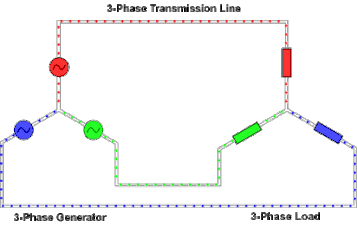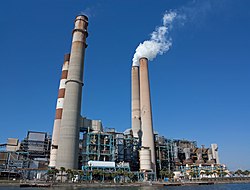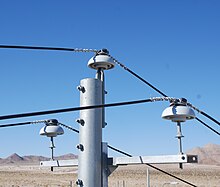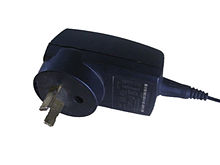ELECTRIC POWER SYSTEM
 |
| A steam turbine used to provide electric power |
An electric powered energy system is a community of electrical additives deployed to supply, switch, and use electric powered energy. An example of a power gadget is the electric grid that gives power to homes and industries within an prolonged area. The electric grid can be widely divided into the generators that supply the power, the transmission system that contains the power from the producing centers to the weight centers, and the distribution system that feeds the energy to close by houses and industries.
Smaller energy structures are also found in industry, hospitals, industrial homes, and homes. A unmarried line diagram enables to symbolize this whole machine. The majority of those structures rely upon three-section AC electricity—the standard for huge-scale energy transmission and distribution across the contemporary world. Specialized power systems that don't always depend on three-phase AC energy are discovered in plane, electric rail structures, ocean liners, submarines, and cars.
History
 |
| A sketch of the pearl street station |
In 1881, two electricians built the arena's first strength device at Godalming in England. It turned into powered by using waterwheels and produced an alternating cutting-edge that in turn supplied seven Siemens arc lamps at 250 volts and 34 incandescent lamps at forty volts.However, supply to the lamps turned into intermittent and in 1882 Thomas Edison and his organization, The Edison Electric Light Company, developed the first steam-powered electric powered electricity station on Pearl Street in New York City. The Pearl Street Station to begin with powered round three,000 lamps for fifty nine customers. The strength station generated direct current day and operated at a single voltage. Direct modern energy couldn't be converted without difficulty or effectively to the better voltages vital to minimize energy loss throughout long-distance transmission, so the maximum economic distance among the turbines and load became restricted to around 1/2 a mile (800 m).
That identical 12 months in London, Lucien Gaulard and John Dixon Gibbs validated the "secondary generator"—the primary transformer suitable to be used in a actual strength gadget. The practical price of Gaulard and Gibbs' transformer turned into validated in 1884 at Turin wherein the transformer turned into used to mild up forty kilometres (25 miles) of railway from a unmarried alternating generator. Despite the achievement of the machine, the pair made some essential mistakes. Perhaps the maximum extreme turned into connecting the primaries of the transformers in series in order that energetic lamps could affect the brightness of other lamps in addition down the road.
In 1885, Ottó Titusz Bláthy working with Károly Zipernowsky and Miksa Déri perfected the secondary generator of Gaulard and Gibbs, supplying it with a closed iron core and its gift call: the "transformer". The three engineers went on to present a electricity device at the National General Exhibition of Budapest that implemented the parallel AC distribution device proposed with the aid of a British scientist[a] wherein several energy transformers have their primary windings fed in parallel from a excessive-voltage distribution line. The gadget lit extra than one thousand carbon filament lamps and operated effectively from May until November of that year.
Also in 1885 George Westinghouse, an American entrepreneur, received the patent rights to the Gaulard-Gibbs transformer and imported a number of them together with a Siemens generator, and set his engineers to experimenting with them in hopes of improving them to be used in a business strength machine. In 1886, one in all Westinghouse's engineers, William Stanley, independently identified the problem with connecting transformers in collection rather than parallel and additionally found out that making the iron center of a transformer a fully enclosed loop would enhance the voltage regulation of the secondary winding.Using this information he built a multi-voltage transformer-based totally alternating-modern power device serving multiple homes and businesses at Great Barrington, Massachusetts in 1886. The gadget become unreliable though (due in general to era troubles) and quick-lived.However based on that device Westinghouse would begin installing AC transformer systems in opposition with the Edison agency later that year. In 1888, Westinghouse certified Nikola Tesla's patents for a polyphase AC induction motor and transformer designs. Tesla consulted for a yr at the Westinghouse Electric & Manufacturing Company's however it took a similarly four years for Westinghouse engineers to expand a plausible polyphase motor and transmission gadget.
By 1889, the electric electricity enterprise was flourishing, and power corporations had constructed heaps of power systems (each direct and alternating cutting-edge) within the United States and Europe. These networks had been effectively dedicated to offering electric lighting. During this time the contention among Thomas Edison and George Westinghouse's organizations had grown into a propaganda campaign over which form of transmission (direct or alternating modern) turned into superior, a series of occasions known as the "war of the currents". In 1891, Westinghouse hooked up the primary predominant electricity system that changed into designed to power a 100 horsepower (75 kW) synchronous electric powered motor, no longer simply offer electric lighting fixtures, at Telluride, Colorado. On the alternative facet of the Atlantic, Mikhail Dolivo-Dobrovolsky and Charles Eugene Lancelot Brown, constructed the primary long-distance (175 km) excessive-voltage (15 kV, then a document) 3-segment transmission line from Lauffen am Neckar to Frankfurt am Main for the Electrical Engineering Exhibition in Frankfurt, in which electricity become used to light lamps and run a water pump.In the USA the AC/DC opposition came to an quit while Edison General Electric become taken over via their leader AC rival, the Thomson-Houston Electric Company, forming General Electric. In 1895, after a protracted selection-making method, alternating modern-day became selected because the transmission general with Westinghouse building the Adams No. 1 generating station at Niagara Falls and General Electric constructing the three-phase alternating cutting-edge energy device to deliver Buffalo at 11 kV.
Developments in electricity systems persevered past the nineteenth century. In 1936 the first experimental high voltage direct current (HVDC) line the usage of mercury arc valves changed into built between Schenectady and Mechanicville, New York.HVDC had previously been accomplished via collection-connected direct modern-day mills and vehicles (the Thury system) even though this suffered from critical reliability issues. The first solid-kingdom metal diode appropriate for general strength uses changed into advanced via Ernst Presser at TeKaDe in 1928. It consisted of a layer of selenium carried out on an aluminum plate. In 1957, a General Electric studies organization advanced the primary thyristor appropriate to be used in strength applications, starting a revolution in strength electronics. In that identical 12 months, Siemens validated a solid-state rectifier, but it changed into no longer till the early Seventies that stable-nation devices have become the standard in HVDC, whilst GE emerged as one of the top suppliers of thyristor-based HVDC. In 1979, a European consortium which include Siemens, Brown Boveri & Cie and AEG realized the report HVDC hyperlink from Cabora Bassa to Johannesburg, extending extra than 1,420 km that carried 1.Nine GW at 533 kV.
In current times, many critical traits have come from extending improvements in the information and communications technology (ICT) field to the energy engineering discipline. For instance, the improvement of computer systems intended load float studies may be run extra efficiently allowing for a whole lot better planning of electricity systems. Advances in statistics technology and telecommunication also allowed for effective far off manipulate of a electricity device's switchgear and turbines.
Basic of electric power
 |
| Animation of three-phase alternating current |
Electric strength is the made of quantities: current and voltage. These quantities can vary with appreciate to time (AC strength) or can be kept at regular degrees (DC power).
Most fridges, air conditioners, pumps and commercial equipment use AC electricity whereas most computer systems and digital equipment use DC energy (digital devices plugged into the mains usually have an internal or outside electricity adapter to convert from AC to DC energy). AC electricity has the gain of being smooth to transform between voltages and is able to be generated and utilised by brushless equipment. DC energy remains the only sensible preference in digital systems and may be more comparatively cheap to transmit over lengthy distances at very excessive voltages (see HVDC).
The capability to without problems transform the voltage of AC power is critical for two motives: Firstly, power can be transmitted over lengthy distances with much less loss at higher voltages. So in strength systems wherein generation is remote from the weight, it is suitable to step-up (boom) the voltage of energy on the era point after which step-down (decrease) the voltage close to the weight. Secondly, it's miles frequently extra reasonably priced to install mills that produce better voltages than could be utilized by most appliances, so the capability to without problems rework voltages means this mismatch between voltages can be without problems managed.
Solid state devices, which are products of the semiconductor revolution, make it viable to convert DC strength to different voltages, build brushless DC machines and convert between AC and DC power. Nevertheless, gadgets utilizing solid state technology are frequently extra expensive than their traditional opposite numbers, so AC strength stays in sizeable use.
Components of power system
Supplies
 |
| Thw majority of the world's power still comes from coal-fired power station like this |
All power systems have one or more assets of strength. For some power structures, the supply of electricity is external to the system but for others, it is a part of the gadget itself—it's far these inner energy sources that are discussed in the remainder of this phase. Direct current power may be furnished through batterises, fuel cell or photovoltaic cells. Alternating contemporary power is usually provided via a rotor that spins in a magnetic field in a tool called a turbo generator. There were a wide variety of strategies used to spin a turbine's rotor, from steam heated the use of fossil gasoline (which include coal, fuel and oil) or nuclear energy to falling water (hydroelectric power) and wind (wind energy).
The speed at which the rotor spins in aggregate with the range of generator poles determines the frequency of the alternating contemporary produced by the generator. All generators on a unmarried synchronous system, as an instance, the national grid, rotate at sub-multiples of the identical speed and so generate electric modern-day at the same frequency. If the burden on the gadget increases, the turbines will require greater torque to spin at that pace and, in a steam power station, extra steam must be supplied to the mills driving them. Thus the steam used and the fuel expended immediately relate to the amount of electrical energy furnished. An exception exists for turbines incorporating strength electronics which include gearless wind turbines or connected to a grid via an asynchronous tie together with a HVDC hyperlink — those can function at frequencies unbiased of the electricity system frequency.
Depending on how the poles are fed, alternating modern-day mills can produce a variable number of phases of power. A better variety of stages ends in more efficient strength device operation but additionally increases the infrastructure requirements of the system.Electricity grid structures join more than one generators running at the equal frequency: the maximum commonplace being three-segment at 50 or 60 Hz.
There are more than a few design issues for energy components. These variety from the plain: How a lot power must the generator be capable of deliver? What is an acceptable length of time for beginning the generator (some generators can take hours to start)? Is the availability of the energy source suitable (a few renewables are most effective available when the sun is shining or the wind is blowing)? To the more technical: How have to the generator begin (some turbines act like a motor to deliver themselves up to the mark in which case they want the correct starting circuit)? What is the mechanical speed of operation for the turbine and consequently what are the range of poles required? What sort of generator is appropriate (synchronous or asynchronous) and what form of rotor (squirrel-cage rotor, wound rotor, salient pole rotor or cylindrical rotor)?
Loads
Power systems supply electricity to loads that carry out a function. These hundreds range from household home equipment to business equipment. Most hundreds assume a positive voltage and, for alternating current gadgets, a positive frequency and range of stages. The appliances determined in residential settings, as an example, will typically be single-section working at 50 or 60 Hz with a voltage among a hundred and ten and 260 volts (depending on countrywide requirements). An exception exists for larger centralized air con systems as in a few nations those at the moment are generally three-segment because this allows them to function more successfully. All electrical home equipment also have a wattage rating, which specifies the amount of power the tool consumes. At any person time, the internet quantity of energy fed on by means of the hundreds on a energy device must equal the internet quantity of power produced through the materials much less the energy misplaced in transmission.
Making certain that the voltage, frequency and amount of power furnished to the masses is in keeping with expectations is one of the remarkable demanding situations of electricity device engineering. However it isn't always the handiest assignment, in addition to the strength used by a load to do beneficial paintings (termed real power) many alternating present day devices additionally use a further quantity of energy because they cause the alternating voltage and alternating modern to end up slightly out-of-sync (termed reactive power). The reactive power like the actual energy must stability (that is the reactive strength produced on a gadget ought to same the reactive electricity fed on) and may be provided from the generators, however it is frequently more reasonably priced to deliver such energy from capacitors (see "Capacitors and reactors" beneath for extra information).
A very last attention with hundreds has to do with strength exceptional. In addition to sustained overvoltages and undervoltages (voltage regulation issues) in addition to sustained deviations from the gadget frequency (frequency regulation troubles), energy gadget loads can be adversely laid low with a number temporal troubles. These include voltage sags, dips and swells, brief overvoltages, flicker, excessive-frequency noise, phase imbalance and poor strength factor.[29] Power high-quality troubles arise while the electricity deliver to a load deviates from the appropriate. Power nice troubles can be especially important in terms of expert business machinery or health center equipment.
Conductor
 |
| Partially insulated medium-voltage conductors in Calfornia |
Conductors convey power from the mills to the load. In a grid, conductors may be categorised as belonging to the transmission system, which includes massive amounts of strength at excessive voltages (commonly more than 69 kV) from the generating centres to the load centres, or the distribution system, which feeds smaller quantities of power at lower voltages (commonly much less than 69 kV) from the load centres to close by houses and industry.
Choice of conductors is primarily based on considerations along with price, transmission losses and other proper traits of the steel like tensile power. Copper, with lower resistivity than aluminum, became once the conductor of desire for maximum energy systems. However, aluminum has a decrease value for the identical current sporting potential and is now often the conductor of choice. Overhead line conductors can be strengthened with metallic or aluminium alloys.
Conductors in outdoors energy structures can be located overhead or underground. Overhead conductors are typically air insulated and supported on porcelain, glass or polymer insulators. Cables used for underground transmission or building wiring are insulated with cross-limked polyethylene or different flexible insulation. Conductors are often stranded for to lead them to greater bendy and consequently less difficult to install.
Conductors are normally rated for the most cutting-edge that they could convey at a given temperature upward push over ambient situations. As present day glide will increase thru a conductor it heats up. For insulated conductors, the score is determined by the insulation. For naked conductors, the rating is decided by the point at which the sag of the conductors would emerge as unacceptable.
Capacitors and reactors
 |
| A synchronous condenser instalation at templestowe substation,Melbourne, Victoria |
The majority of the burden in a standard AC electricity machine is inductive; the modern-day lags at the back of the voltage. Since the voltage and modern-day are out-of-phase, this ends in the emergence of an "imaginary" shape of strength referred to as reactive power. Reactive electricity does no measurable paintings but is transmitted back and forth among the reactive power supply and cargo each cycle. This reactive electricity may be provided by means of the generators themselves however it's far regularly cheaper to provide it thru capacitors, as a result capacitors are regularly placed near inductive masses (i.E. If no longer on-web site at the nearest substation) to lessen present day demand at the strength machine (i.E. Growth the power factor).
Reactors eat reactive energy and are used to adjust voltage on lengthy transmission strains. In mild load conditions, in which the loading on transmission lines is nicely below the surge impedance loading, the efficiency of the power gadget may additionally surely be advanced by using switching in reactors. Reactors mounted in collection in a energy machine additionally restrict rushes of modern-day float, small reactors are therefore almost constantly installed in series with capacitors to restriction the cutting-edge rush associated with switching in a capacitor. Series reactors also can be used to limit fault currents.
Capacitors and reactors are switched via circuit breakers, which results in fairly massive step modifications of reactive power. A way to this comes in the form of synchronous condensers, static VAR compensators and static synchronous compensators. Briefly, synchronous condensers are synchronous motors that spin freely to generate or soak up reactive power.Static VAR compensators paintings by using switching in capacitors using thyristors rather than circuit breakers allowing capacitors to be switched-in and switched-out inside a unmarried cycle. This offers a miles more refined response than circuit-breaker-switched capacitors. Static synchronous compensators take this a step further by using achieving reactive power modifications using best power electronics.
Power electronics
 |
| This external household AC to DC power adapter uses power electronics |
Power electronics are semiconductor based totally gadgets which can be capable of transfer portions of power starting from some hundred watts to numerous hundred megawatts. Despite their especially easy feature, their speed of operation (typically in the order of nanoseconds) method they're able to a extensive variety of responsibilities that would be hard or impossible with traditional technology. The conventional function of electricity electronics is rectification, or the conversion of AC-to-DC electricity, energy electronics are therefore located in nearly each virtual tool that is furnished from an AC source both as an adapter that plugs into the wall (see photo) or as thing inner to the device. High-powered strength electronics can also be used to transform AC energy to DC electricity for lengthy distance transmission in a device known as HVDC. HVDC is used as it proves to be greater most economical than similar high voltage AC systems for extremely long distances (loads to thousands of kilometres). HVDC is likewise desirable for interconnects as it allows frequency independence consequently improving machine balance. Power electronics also are critical for any strength supply this is required to supply an AC output however that by its nature produces a DC output. They are consequently utilized by photovoltaic installations.
Power electronics additionally characteristic in a huge variety of extra exotic makes use of. They are at the coronary heart of all current electric and hybrid cars—in which they're used for each motor control and as a part of the brushless DC motor. Power electronics also are located in almost all modern petrol-powered vehicles, this is because the power supplied via the auto's batteries on my own is inadequate to offer ignition, air-conditioning, internal lighting, radio and dashboard shows for the life of the automobile. So the batteries must be recharged at the same time as using—a feat that is usually carried out the use of strength electronics. Whereas conventional generation might be incorrect for a present day electric powered vehicle, commutators can and had been utilized in petrol-powered motors, the switch to alternators in combination with energy electronics has happened because of the advanced durability of brushless equipment.
Some electric railway structures additionally use DC electricity and as a result make use of energy electronics to feed grid energy to the locomotives and regularly for velocity manage of the locomotive's motor. In the middle twentieth century, rectifer Locomotives were popular, those used energy electronics to convert AC energy from the railway community for use by a DC motor. Today most electric locomotives are furnished with AC electricity and run the usage of AC motors, but nevertheless use power electronics to provide appropriate motor manage. The use of electricity electronics to help with the motor manipulate and with starter circuits, similarly to rectification, is liable for strength electronics appearing in a extensive range of business machinery. Power electronics even seem in present day residential air conditioners permit are on the coronary heart of the variable pace wind turbine.
WRITTEN BY : ADRISH WAHEED
Labels: ELECTRIC POWER SYSTEM

0 Comments:
Post a Comment
Subscribe to Post Comments [Atom]
<< Home